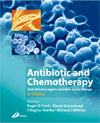|
|
|
| |
 |
|
|

|
 推薦指數:
推薦指數:





|
|
- 內容介紹
|
Antibiotic and Chemotherapy, 8th Edition - Anti-Infective Agents and Their Use in Therapy
By Roger G Finch, FRCP, FRCPath, FFPM, David Greenwood, BSc, PhD, DSc, FRCPath, S. Ragnar Norrby and Richard J Whitley, MD
1000 pp., 275 ills., Copyright 2003Description
The completely revised and updated New Edition of this respected resource presents globally-relevant coverage of all types of antimicrobial agents used in human medicine, providing authoritative guidance on the principles and practice of antimicrobial chemotherapy. In addition to full coverage of every commonly used antibiotic agent, it includes complete coverage of all antiviral, antiprotozoan and anthelminthic agents. And, its unique 3-part structure makes it easy to locate information: Part I covers general aspects of treatment; Part II reviews every agent, including antimicrobial activity, pharmacokinetics, clinical use, and available preparations; Part III details the treatment of particular infections.
New to this Edition
Discusses the increasing problem of multi-drug resistance and the wide range of new antiviral therapies now available for the treatment of HIV and other viral infections.
Reviews all of the new antimicrobial agents in detail.
Features more clinically focused sections on Pharmacokinetics.
Details new antifungal therapies, including voriconazole, liposomal, and amphotericin B.
Presents new tables on major drug interactions, placental transfer, and concentrations of agents in breast milk.
Features new sections on liver failure, drug development and licensing, and the implications of xenotransplantation.
Presents expanded coverage of Quinolone as well as new antimalarial combination therapies.
Offers cross-references to key web sites, for up-to-date information on treatment and drug resistance.
Table of Contents
Part I: General Aspects 1. Historical Introduction 2. Modes of Action 3. The Problem of Resistance 4. General Principles of Pharmockinetics and Pharacodynamics 5. Antibiotics in Renal Failure 6. Drug Interactions Involving Antomicrobial Agents 7. Antibiotics and Immune System 8. General Principles of Chemotherapy 9. Laboratory Control of Antimicrobial Therapy 10. Principles of Chemoprophylaxis 11. Antibiotic Policies 12. Drug discoveries – pre – clinical 13. Drug discoveries – clinical trail stage
Part II: Agents 14. Aminoglycosides and aminocyclitols 15. Beta-lactams: Cephalosporins 16. Beta-lactams: Penicillins 17. Other Beta-lactams 18. Chloramphenicol and Thiamphenicol 19. Diaminopyrimidines 20. Fosfomycin and Fosmidomycin 21. Fusidanes 22. Glycopepties 23. Lincosamides 24. Macrolides and ketolides 25. Mupirocin 26. Nitrofurans 27. Nitroimidazoles 28. Oxazolidinones 29. Quinolones 30. Rifamycins 31. Streptogramins 32. Sulphonamides 33. Tetracyclines 34. Other antibacterial agents (coumairns, cyclic petides, amino acid analogues & oligopeptides 35. Antifungal Agents 36. Antimycobacterial Agents 37. Anthelmintics 38. Antiprotozoal Agents 39. Antiviral Agents – anti-HIV 40. Antiviral Agents – other
Part III: Treatment 41. Sepsis 42. Abdominal and Other Surgical Infections 43. Infections Associated with Neutropenia 44. Infections in Intensive Care Patients 45. Infections Associated with Implanted Devices 46. HIV and AIDS 47. Infections of the Upper Respiratory 48. Infections of the Lower Respiratory Tract 49. Endocarditis 50. Infections of the Gastro – Intestinal Tract 51. Hepatitis 52. Infections of the Skin and Soft Tissues 53. Infections of the Central Nervous System – Bacterial 54. Infections of the Central Nervous System – Viral 55. Bone and Joint Infections 56. Infections of the Eye 57. Urinary Tract Infections 58. Infections of Obstetrics 59. Sexually Transmitted Infections 60. Leprosy 61. TB and other Mycobacterial Infections 62. Fungal Infections 63. Zoonoses 64. Malaria 65. Other Protozoal Infections 66. Helminthic Infections
|
|
|

